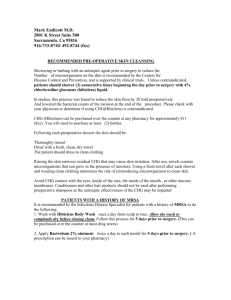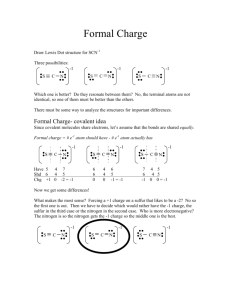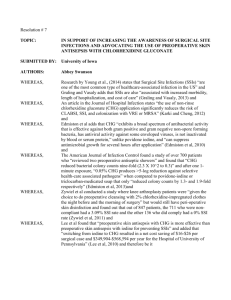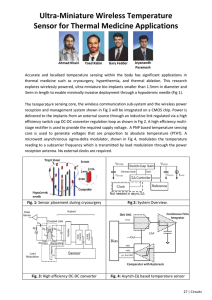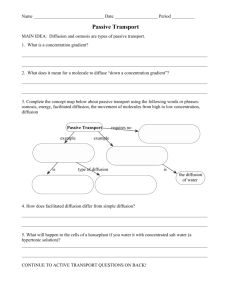Additionally, existing detectors are often ... devices/systems, requiring complex
advertisement
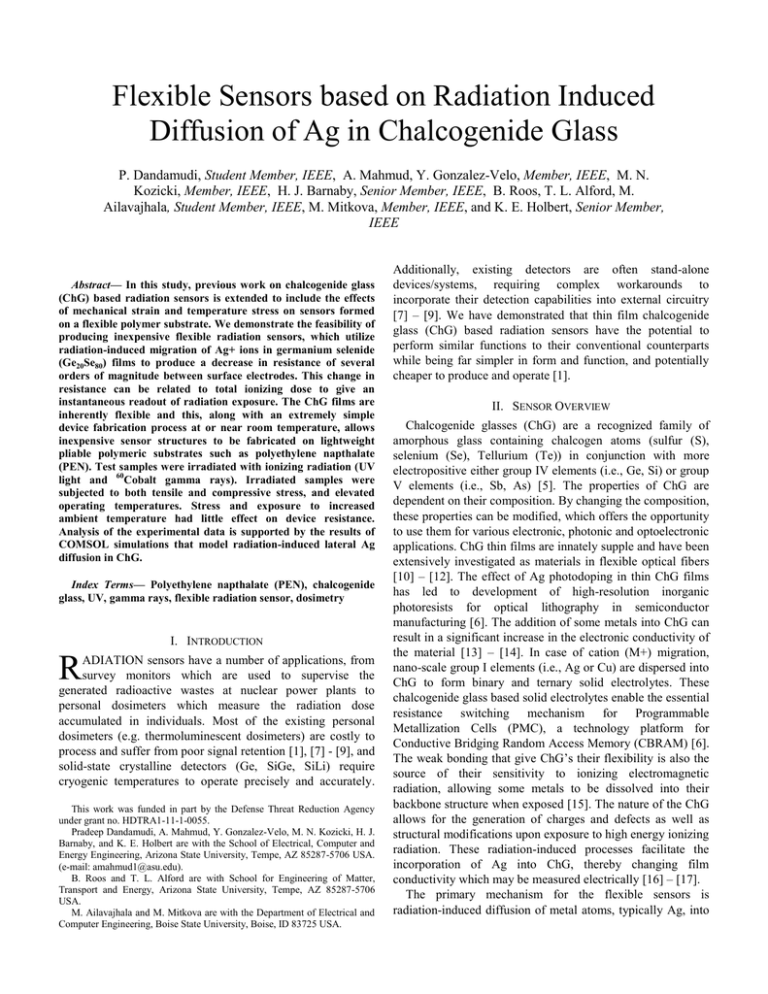
Flexible Sensors based on Radiation Induced Diffusion of Ag in Chalcogenide Glass P. Dandamudi, Student Member, IEEE, A. Mahmud, Y. Gonzalez-Velo, Member, IEEE, M. N. Kozicki, Member, IEEE, H. J. Barnaby, Senior Member, IEEE, B. Roos, T. L. Alford, M. Ailavajhala, Student Member, IEEE, M. Mitkova, Member, IEEE, and K. E. Holbert, Senior Member, IEEE Abstract— In this study, previous work on chalcogenide glass (ChG) based radiation sensors is extended to include the effects of mechanical strain and temperature stress on sensors formed on a flexible polymer substrate. We demonstrate the feasibility of producing inexpensive flexible radiation sensors, which utilize radiation-induced migration of Ag+ ions in germanium selenide (Ge20Se80) films to produce a decrease in resistance of several orders of magnitude between surface electrodes. This change in resistance can be related to total ionizing dose to give an instantaneous readout of radiation exposure. The ChG films are inherently flexible and this, along with an extremely simple device fabrication process at or near room temperature, allows inexpensive sensor structures to be fabricated on lightweight pliable polymeric substrates such as polyethylene napthalate (PEN). Test samples were irradiated with ionizing radiation (UV light and 60Cobalt gamma rays). Irradiated samples were subjected to both tensile and compressive stress, and elevated operating temperatures. Stress and exposure to increased ambient temperature had little effect on device resistance. Analysis of the experimental data is supported by the results of COMSOL simulations that model radiation-induced lateral Ag diffusion in ChG. Index Terms— Polyethylene napthalate (PEN), chalcogenide glass, UV, gamma rays, flexible radiation sensor, dosimetry I. INTRODUCTION R ADIATION sensors have a number of applications, from survey monitors which are used to supervise the generated radioactive wastes at nuclear power plants to personal dosimeters which measure the radiation dose accumulated in individuals. Most of the existing personal dosimeters (e.g. thermoluminescent dosimeters) are costly to process and suffer from poor signal retention [1], [7] - [9], and solid-state crystalline detectors (Ge, SiGe, SiLi) require cryogenic temperatures to operate precisely and accurately. This work was funded in part by the Defense Threat Reduction Agency under grant no. HDTRA1-11-1-0055. Pradeep Dandamudi, A. Mahmud, Y. Gonzalez-Velo, M. N. Kozicki, H. J. Barnaby, and K. E. Holbert are with the School of Electrical, Computer and Energy Engineering, Arizona State University, Tempe, AZ 85287-5706 USA. (e-mail: amahmud1@asu.edu). B. Roos and T. L. Alford are with School for Engineering of Matter, Transport and Energy, Arizona State University, Tempe, AZ 85287-5706 USA. M. Ailavajhala and M. Mitkova are with the Department of Electrical and Computer Engineering, Boise State University, Boise, ID 83725 USA. Additionally, existing detectors are often stand-alone devices/systems, requiring complex workarounds to incorporate their detection capabilities into external circuitry [7] – [9]. We have demonstrated that thin film chalcogenide glass (ChG) based radiation sensors have the potential to perform similar functions to their conventional counterparts while being far simpler in form and function, and potentially cheaper to produce and operate [1]. II. SENSOR OVERVIEW Chalcogenide glasses (ChG) are a recognized family of amorphous glass containing chalcogen atoms (sulfur (S), selenium (Se), Tellurium (Te)) in conjunction with more electropositive either group IV elements (i.e., Ge, Si) or group V elements (i.e., Sb, As) [5]. The properties of ChG are dependent on their composition. By changing the composition, these properties can be modified, which offers the opportunity to use them for various electronic, photonic and optoelectronic applications. ChG thin films are innately supple and have been extensively investigated as materials in flexible optical fibers [10] – [12]. The effect of Ag photodoping in thin ChG films has led to development of high-resolution inorganic photoresists for optical lithography in semiconductor manufacturing [6]. The addition of some metals into ChG can result in a significant increase in the electronic conductivity of the material [13] – [14]. In case of cation (M+) migration, nano-scale group I elements (i.e., Ag or Cu) are dispersed into ChG to form binary and ternary solid electrolytes. These chalcogenide glass based solid electrolytes enable the essential resistance switching mechanism for Programmable Metallization Cells (PMC), a technology platform for Conductive Bridging Random Access Memory (CBRAM) [6]. The weak bonding that give ChG’s their flexibility is also the source of their sensitivity to ionizing electromagnetic radiation, allowing some metals to be dissolved into their backbone structure when exposed [15]. The nature of the ChG allows for the generation of charges and defects as well as structural modifications upon exposure to high energy ionizing radiation. These radiation-induced processes facilitate the incorporation of Ag into ChG, thereby changing film conductivity which may be measured electrically [16] – [17]. The primary mechanism for the flexible sensors is radiation-induced diffusion of metal atoms, typically Ag, into the ChG (GexSe1-x in our studies), which results in change in the resistivity of the glass. The more Ag dissolved in the ChG, the lower the resistance of the resulting Ag-Ge-Se ternary. In addition, sensor operation does not require an applied bias during exposure and can be related to the dose, via calibration and modeling, to provide an instantaneous readout at very low voltage. Fig. 1 shows the overview of the ChG sensor. The device is compact in size, mass-manufacturable, and can be easily incorporated in the back end of a standard integrated circuit process flow, making it a good candidate for the next generation of portable, electronic, field dosimeters. the ChG at a rate of 0.1 nm/s using the same tool but this time a shadow mask is used to form square arrays of 50 nm thick, 2 mm diameter circular electrodes with 1 mm spacing. The sensor cross-section is shown in Fig. 3. Fig. 1. ChG sensor overview: When the ChG sensors are exposed to ionizing radiation, the deposited energy causes Ag dissolution in ChG and the resulting resistivity change can be detected by the electrical resistance at the output. Our previous work concentrated on ChG radiation sensors fabricated on rigid substrates [1] but in this paper we show the results of ChG-based sensors formed on a flexible polymer substrate. Flexible sensors are potentially more useful than rigid variants as they can be readily (and conformally) attached to non-flat objects such as flasks, barrels, and pipes; and they are inherently more robust as they will resist breaking when mechanically stressed. They are also potentially lighter than rigid versions as they can be formed on thin plastic substrates. In addition, flexible substrates allow roll-to-roll processing and hence fabrication costs can be very low. Fig. 2. Sensor fabrication process flow III. DEVICE FABRICATION AND TEST PROTOCOL The basic sensor fabrication method involves: (1) deposition of a thin ChG film, in this case Ge20Se80, on a flexible substrate and (2) formation of soluble Ag electrodes. The Ag electrodes supply the metal into the underlying ChG during exposure as well as providing the electrical connection to the layer for resistance measurement [1]. The Ge20Se80 composition was chosen as Ag diffuses rapidly in this Se-rich material [18] – [21]. In addition and just as importantly for this application, the low processing temperature (detailed below) and very high elastic modulus of the Ge20Se80 based glass makes this material an ideal choice for fabricating ChG on flexible substrates. Low processing temperature is necessary as most (low cost) polymer substrates cannot withstand high temperatures (e.g., over 180°C). It should be noted that the low hardness values, brittleness factor, hardness, and Young’s modulus of the material are much lower than silicate glass [22]; and as a result, ChG films demonstrate more elastic deformation for the same amount of stress [23]. The fabrication sequence is depicted in Fig. 2. First, a 10 nm blanket Ge20Se80 film is deposited at room temperature onto a 125 µm thick polyethylene napthalate (PEN) substrate at a deposition rate of 0.1 nm/s in a Cressington 308 thermal evaporator. Then, Ag is evaporated at room temperature onto Fig. 3. Cross-sectional schematic of the sensor layout. In order to assess device performance, the test samples were exposed to UV light at power density of 2.67 mW/cm2 at a wavelength of 324 nm for a 1 h exposure. This corresponds to a total energy absorption density of 9.61 J/cm2. The use of UV light was shown in our previous studies [1] – [4] to be a simple and convenient substitute for ionizing radiation as both generate charged carriers and induce the dissolution of the metal into the ChG film. Samples, irradiated with UV doses up to 57.6 J/cm2 (as shown in Fig. 4) and unexposed control samples, were monitored to detect Ag incorporation optically during the testing. For 60Co gamma-ray exposure, the samples were placed in a Gammacell 220 irradiator with a dose rate of 477.5 rad(Ge20Se80)/min. The samples were periodically removed from the Gammacell to measure the change in electrical resistance with respect to increasing dose levels. Samples were exposed to a maximal total ionizing dose (TID) of 5.13 Mrad(Ge20Se80) and the samples were left floating (electrodes unconnected) during the exposures. (a) IV. RESULTS AND DISCUSSION (b) Fig. 4. (a) Array of ChG sensors on a flexible copper-polyimide substrate. (b) Unexposed and UV exposed sensor array on a flexible PEN substrate. The devices are 10 nm thick Ge20Se80 film and the devices were saturated after 57.6 J/cm2 of UV dose. Resistance measurements were performed at room temperature using semiconductor parameter analyzers (SPA, Agilent 4155B for devices exposed to UV, and 4156C for devices exposed to 60Co gamma-rays). The resistance between two adjacent Ag electrodes was monitored for 100s at 10 mV bias. The low measurement bias was necessary to minimize redox reactions at the electrodes but also demonstrate that these devices do not require high voltage for readout. The metal photo-dissolution behavior observed in chalcogenide glasses has been extensively studied in recent years because of its potential application in producing highresolution lithography, electrochemical resistive memory devices and optical components. Figs. 6a & 6b show the photo-doping process at Ag/ChG interface under irradiation. In the case of the photo-dissolution of Ag, light illumination creates charged defects in the ChG and the photocarriers absorbed at the Ag-ChG junction cause the diffusion of the Ag into the glass. The presumed mechanism [25] is that the Ag metal traps holes and the junction potential causes electrons to move deeper into the ChG film and become trapped there. Fig. 6c shows an optical micrograph of an unexposed 10 nm thick Ge20Se80 film with Ag electrodes formed on its surface. Prior to exposure to gamma-rays, the device is in its high resistance OFF state of around 1011 Ω, since the undoped ChG (no Ag in film) acts primarily as a dielectric layer between the electrodes. (a) (b) (c) (d) Fig. 5. Flexible sensor arrays being bent around tubes of (a) 18 mm, (b) 7 mm diameter. The sensor devices were bent around tubes of various radii for 96 hrs and were later re-flattened for electrical measurements. The bending operation is illustrated by the photographs in Fig. 5. Resistance measurements were taken before and after bending. The tensile stress was applied by bending the devices outward while compressive stress was applied with inward bending. All bending radii (R) are converted to percent strain (ε) by where is the thickness of PEN substrate (125 µm), is thickness of the sensor film (~ 10 nm) and is the bending curvature radius of the substrate [24]. A bending radius of 5 mm therefore corresponds to 1.25 % strain. The effects of exposure to elevated temperatures on the performance of the sensors were investigated to assess how these devices would perform in high temperature environments. Devices exposed to UV light and control samples were heated on a hot plate to 75, 100, 125 and 150°C for 1 hr. and resistance between adjacent electrodes was measured following the temperature stress. (e) (f) Fig. 6. (a, b) illustration of the the photo-doping process at the Ag-ChG interface. (c-f) Optical micrographs show evolution of 60Co gamma irradiation induced Ag lateral diffusion in a 10 nm thick Ge20Se80 device on a flexible PEN substrate: (a) after 680krad(Ge20Se80) (b) after 1.22Mrad(Ge20Se80) (c) and (d) after 1.87Mrad(Ge20Se80). The lateral progression of Ag (diffusion front) into the film is observed in Figs. 6(c) as a change in contrast of the ChG in the micrograph, but it is obvious that an undoped ChG layer still exists between the Ag diffusion fronts (Fig. 6c). After 1.22 Mrad(Ge20Se80), as shown in Fig. 6d, the Ag has diffused laterally but an undoped ChG layer remains between the two electrodes. Hence, at this TID, the device remains in a high resistance OFF-state. Fig. 6e and 6f show a further diffusion of the Ag at TID close to 2 Mrad(Ge20Se80). There are no longer undoped regions in the ChG layer and the resistance between adjacent electrodes drops. The evolution of resistance obtained after 60Co gamma exposure is presented in Fig 7. It is important to note here that reduction of resistance (from 1011 Ω to 109 Ω) of some of the unexposed control samples were observed during our data collection. This reduction occurs due to the natural dissolution process of silver into the chalcogenide glass. Resistance () 0.0 10 12 10 11 10 10 10 9 10 8 10 7 10 6 10 5 10 4 10 3 Time3 (minutes) 3 4.2x10 8.4x10 1.3x10 sensor devices measured before bending (in the order of 10 – 12 kΩ). Excessive bending strain, caused by bending with radius < 2 mm, induced cracks along the sensor electrodes and this increased the device resistance to around 106 Ω (this could be related to the cracks generated at the fringes of the substrate while the substrate was cut for mechanical strain). The unexposed samples did not show any Ag diffusion related to bending strain and retained their OFF-state resistance (around 1012 Ω). 4 High Resistance State OFF state Sample 1 Sample 2 Sample 3 Sample 4 Sample 5 Control Fig. 8. ON-state resistance as a function of applied strain (ε). OFF-state resistance is ~ 1012 Ω. 0.0 2.0x10 6 4.0x10 6 6.0x10 6 Dose (Rad) Fig. 7. Evolution of resistance prior to exposure, and after exposure to 630 krad(Ge20Se80), 2.61 Mrad(Ge20Se80), 3.29 Mrad(Ge20Se80), 3.83 Mrad(Ge20Se80), 4.49 Mrad(Ge20Se80) and 5.21 Mrad(Ge20Se80) A similar decrease of the resistance has been observed on devices exposed to UV light. For those UV exposed devices, prior to exposure, the device is in a high resistance OFF state of around 1012 Ω, since the undoped ChG (no Ag in film) acts as a dielectric layer between the electrodes. After 19.22 J/cm2 of UV exposure, the Ag has diffused laterally by more than 0.5 mm between the electrodes. A complete “saturation” of the ChG film with Ag is observed at 43.25 J/cm2 of UV exposure. As mentioned previously, the simple room temperature fabrication method developed in this study and the flexibility of the Ge20Se80 based glass enables the manufacture of flexible sensor structures. However, the performance of the sensor under bending stresses should also be assessed to ensure that the materials do not undergo major electrical changes as a result of stress. Fig. 8 shows the change in ON-state resistance when the exposed device is subjected to parallel and perpendicular stress, both tensile and compressive. For all measurements, several sensor samples were bent for 96 h on cylindrical surfaces of various radius and then probed on a flat surface to measure their resistance. As shown in Fig. 8, the ON-state resistance of the device did not show significant degradation and falls within the range of resistance values of Fig. 9: ON-state resistance as a function of temperature annealing T (OC). OFF-state resistance is ~ 1012 Ω Finally, the effect of elevated operating temperature on sensor characteristics was assessed. Fig. 9 shows the ON-state resistance as a function of temperatures between room temperature and 150 °C. Once again, the ON-state resistance falls within the range of resistance values of the sensor devices measured before temperature stressing (10 – 12 kΩ). Although the OFF-state resistance shows no change with temperature, it is understood that prolonged high-temperature annealing could cause silver diffusion in the ChG [25]. the simulation accurate was the diffusion coefficient of the silver ions in Ge20Se80 chalcogenide glass. As it is commonly known, Ag does not have a constant diffusion coefficient. Instead, this value is dependent on the silver concentration within the chalcogenide glass. From ref. [26], the diffusion coefficient was determined to be 1.15 x10-11 m2/sec for a Ag concentration of 10 at.% Ag and 1.16 x10 -10 m2/sec for 20 at.% Ag. An approximation was made of source Ag concentration at the interface between the silver and the chalcogenide glass film. This is an arbitrary number of atoms that will not affect the overall simulation result. Initial concentration was assumed to be 1000 mol/m3. The diffusion simulations were performed by applying adjusted Fick’s diffusion laws and calculating the diffusion dependence on time/concentration using COMSOL simulations. The continuity equation for this process is A. Finite Element Simulation Results Fig. 10. COMSOL simulations modeling the diffusion profile achieved using UV light which is similar to the 60Co gamma irradiation induced Ag lateral diffusion shown in Fig. 4. 1.2 0 hr 2.5 hr 3.5 hr 6.5 hr Normalized Concentration 1.0 0.8 0.6 0.4 0.2 where c is Ag concentration, i is the value from the previous iteration, D is the diffusion coefficient, and v is the velocity of the diffusant. After creating the specific device structure, initial conditions were assumed such that the perimeter of the simulation area was always at 0 mol/m3 and all the diffusing species are confined within this area. The source of the diffusing species was created such that a constant concentration of 1000 mol/m3 is always present around each of the silver sources independent of the previous iteration result. Due to the velocity and diffusion coefficient values chosen, the simulation time was similar to the experimental time. The entire transient simulation was performed from t=0 to t=23,400 seconds with 60 time steps. The results in Fig. 10 are given for the various time intervals. Quantitative simulations were performed where Ag concentrations were extracted along cut lines made diagonally between two Ag electrodes. Fig. 11 plots the evolution of the normalized neutral Ag concentration along the cut lines. The figure shows that with increasing dose, Ag diffuses into the ChG film. Increasing radiation dose causes the ChG film to contain higher quantities of Ag, thereby lowering the resistivity of the ChG film between the Ag electrodes. V. CONCLUSION 0.0 -0.8 -0.6 -0.4 -0.2 0.0 0.2 0.4 0.6 0.8 Distance (mm) Fig. 11. Evolution of Ag distribution between electrodes with increasing UV exposure time. The lateral diffusion of Ag into the ChG was modeled using COMSOL. Fig. 10 shows simulation results that broadly match the experimental results of the devices exposed to UV light. Based on the results obtained after 2.5 hrs of exposure, the diffusion distance is approximately 0.5 mm from each of the electrodes. This value was used to determine the rate of diffusion as 5.6 x 10-8 m/s. Another quantity required to make In this work, we investigated flexible radiation-sensing devices which rely upon resistance change in flexible Ge20Se80 films as a result of radiation-induced diffusion of Ag into the chalcogenide glass. The sensors were stressed mechanically by bending them inward and outward to produce a range of compressive and tensile stresses and were also exposed to elevated temperatures to assess their stability. The OFF- and ON-state resistances of the devices did not show significant degradation following mechanical or thermal stress although further research is needed to understand the limits of such operational trauma. COMSOL simulations of Ag transport reproduced the experimental results by modeling ion transport equations and their reactions with electrons and holes generated during radiation exposure. The results of this study are promising as they reveal that very simple, low cost fabrication techniques can be employed to create a flexible radiation sensor capable of withstanding high bending strain without compromising device functionality or structural integrity. The sensors are thin, lightweight, and capable of instantaneous readout with a low voltage. All of these positive factors make this technology a strong candidate in the field of electronic radiation dosimetry. ACKNOWLEDGMENT The authors would like to thank Dr. James Reed of DTRA for his support of this work. Also, we gratefully acknowledge the use of facilities within the LeRoy Eyring Center for Solid State Science (LE-CSSS) and Center for Solid State Electronic Research (CSSER) at Arizona State University. [18] [19] [20] [21] [22] [23] [24] REFERENCES [1] [2] [3] [4] [5] [6] [7] [8] [9] [10] [11] [12] [13] [14] [15] [16] [17] P. Dandamudi, M. N. Kozicki, H. J. Barnaby, Y. Gonzalez-Velo, K. E. Holbert, and M. Mitkova, “Sensors Based on Radiation-Induced Diffusion of Silver in Germanium Selenide Glasses,” IEEE Trans. Nucl. Sci., vol. 60, no. 6, pp. 4257–4264, Dec. 2013. Y. Gonzalez-Velo, H. J. Barnaby, M. N. Kozicki, P. Dandamudi, A.Chandran, K. Holbert, M. Mitkova, and M. Ailavajhala, “Totalionizing-dose effects on the resistance switching characteristics of chalcogenide programmable metallization cells,” IEEE Trans. Nucl. Sci., vol.60, no. 6, pp. 4563–4569, Dec. 2013. Dandamudi, P., M. N. Kozicki, H. J. Barnaby, Y. Gonzalez-Velo, and K. E. Holbert, "Total Ionizing Dose Tolerance of based Programmable Metallization Cells," IEEE Trans. Nucl. Sci., vol.61, no. 4, pp. 1726– 1731, Aug. 2014. M. N. Kozicki, P. Dandamudi, H. J. Barnaby, and Y. Gonzalez-Velo, “Programmable metallization cells in memory and switching applications,” ECS Trans., vol. 58, no. 5, pp. 47–52, 2013. A. B. Seddon, “Chalcogenide glasses: a review of their preparation, properties and applications,” J. Non-Cryst. Solids, vol. 184, pp. 44-50, 1995. N. Mehta, “Applications of chalcogenide glasses in electronics and optoelectronics: A review,” J. Sci. Ind. Res., vol. 65, pp. 777-786, Oct. 2006. G. F. Knoll, Radiation Detection and Measurement, 4th ed. USA: Wiley, 2010. J.G. Webster, Medical Instrumentation Application and Design, 4th ed. USA: Wiley, 2009. E. B. Podgorsak, Radiation Oncology Physics: A Handbook for Teachers And Students. Austria: International Atomic Energy Agency, 2005. J. S. Sanghera, and I. D. Aggarwal, “Active and passive chalcogenide glass optical fibers for IR applications: a review,” J. Non-Cryst. Solids, vol. 256-257, pp. 6-16, Oct. 1999. J. S. Sanghera, L. B. Shaw, and I. D. Aggarwal, “Chalcogenide glassfiber-based mid-IR sources and applications,” IEEE J. Sel. Topics Quantum Electron, vol. 15, no. 1, pp. 114-119, 2009. J. Yun, K. Cho, and S. Kim, “Flexible logic circuits composed of chalcogenide-nanocrystal-based thin film transistors,” Nanotechnology, vol. 21, no. 23, p. 235204, May 2010. M. A. Ureña, A. A. Piarristeguy, M. Fontana, and B. Arcondo, “Ionic conductivity (Ag+) in AgGeSe glasses,” Solid State Ionics, vol. 176, pp. 505–512, Feb. 2005. M. Kawasaki, J. Kawamura, Y. Nakamura, and M. Aniya, “Ionic conductivity of Agx (GeSe3)1-x(0 < x < 0.571) glasses,” Solid State Ionics, vol. 123, pp. 259–269, Aug. 1999. A. Zakery, S. R. Elliot, Optical Nonlinearities in Chalcogenide Glasses and their Applications, Springer, Berlin Heidelberg, 2007. V. O. Balitska and O. I. Shpotyuk, “Radiation-induced structural transformations in vitreous chalcogenide semiconductors,” J. Non-Cryst. Solids, vol. 227–230, pp. 723–727, 1998. Y. Gonzalez-Velo, H. J. Barnaby, A. Chandran, D. R. Oleksy, P. Dandamudi, M. N. Kozicki,K. E. Holbert,M.Mitkova,M.Ailavajhala, and P. Chen, “Effects of cobalt-60 gamma—rays on Ge-Se chalcogenide [25] [26] glasses and Ag/Ge-Se test structures,” IEEE Trans. Nucl. Sci., vol. 59, no. 6, pp. 3093–3100, Dec. 2012. A. V. Kolobov, Photo-induced Metastability in Amorphous Semiconductors. Wiley-VCH, 2003. A. V. Kolobov, S. R. Elliott, “Photodoping of amorphous chalcogenides by metals,” Advances in Physics, vol. 40, pp. 625-684, Sep. 1991. M. Frumar and T. Wagner, "Ag doped chalcogenide glasses and their applications," Curr. Opin. Solid State Mater. Sci., vol. 7, pp.117 -126, April 2003. M. Mitkova, M. N. Kozicki, H. C. Kim, and T. L. Alford, “Crystallization effects in annealed thin Ge-Se films photodiffused with Ag,” J. Non-Cryst. Solids, vol. 352, pp. 1986–1990, 2006. J. P. Guin, T. Rouxel, J. C. Sanglebœuf, I. Melscoët, and J. Lucas, “Hardness, toughness, and scratchability of germanium–selenium chalcogenide glasses,” J. Am. Ceram. Soc., vol. 85, no. 6, pp. 15451552, June 2002. S. R. Baliga, S. C. P. Thermadam, D. Kamalanathan, D. R. Allee, and M. N. Kozicki, “Solid electrolyte memory for flexible electronics,” Proc. 2007 Non-Volatile Memory Symp. P. 85. J. Jang , F. Pan , K. Braam , and V. Subramanian, “Resistance Switching Characteristics of Solid Electrolyte Chalcogenide Ag2Se Nanoparticles for Flexible Nonvolatile Memory Applications,” Adv. Mater., vol. 24, no. 26, pp. 3573-3576, July 2012. M. Mitkova, M. N. Kozicki, H. C. Kim, and T. Alford, “Local structure resulting from photo and thermal diffusion of Ag in Ge-Se films,” J. Non-Cryst. Solids, vol. 338, pp. 552–556, 2004. B. Cai, B. Prasai, and D. A. Drabold. (2011, March 30). Atomistic Simulations of Flash Memory Materials Based on Chalcogenide Glasses [Online]. Available: http://arxiv.org/abs/1103.6051v1
